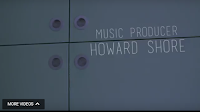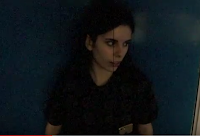Looking back at your preliminary task, what do you feel like you have learnt in the progression from it to the full product?

As the groups cinematographer, I worked with DSLRS - which was a new experience for me. However, throughout the process it made me more aware of everything's position in the frame; what should be and should not be included. This became highly important as the placing of everything affected how the credits would be placed later. Although the cinematography turned out relatively successful - there was still some struggles on my behalf and technical issues that hindered our results. The tapping scene, for example, was quite difficult to film, this is because of the angle the hand comes from - and our intention was to make it look like a PoV shot. However, due to us wanting to keep the close-up theme for the white screen scenes the shot did not work, making the performance seem awkward and robotic. DSLRS aren't cameras specially for designed filming such as a RED Epic, but they provided relatively successful results. But as mentioned before, there were technical issues. These issues followed from the continuity sequence, when, we struggled to capture the close up of the phone - as the camera would go out of focus if we go too close. This also happened during our filming for the poison scene - we wanted an extreme close up, but again, the camera would go out of focus. We learnt to work around these issues.

 Filming the continuity sequence was hard for me, as i was new to it and wasn't use to a DSLR. However, it went surprisingly well - i was able to frame shots to create an atmosphere. Which is seen in the bottom screenshot, as by doing a slight high-angle shot it made Maddie's character look small and weak. This added to the tension of our sequence.There were a few techniques used in the preliminary task that helped develop my skill and made the filming of Women's Bane easier. For example the tack shot up Kelly's body and the slight pov over the shoulder shots, helped me to figure out positioning in the frame. Panning and shot-reverse-shots helped to establish character relations - which would be important between our protagonist and her victim.
Filming the continuity sequence was hard for me, as i was new to it and wasn't use to a DSLR. However, it went surprisingly well - i was able to frame shots to create an atmosphere. Which is seen in the bottom screenshot, as by doing a slight high-angle shot it made Maddie's character look small and weak. This added to the tension of our sequence.There were a few techniques used in the preliminary task that helped develop my skill and made the filming of Women's Bane easier. For example the tack shot up Kelly's body and the slight pov over the shoulder shots, helped me to figure out positioning in the frame. Panning and shot-reverse-shots helped to establish character relations - which would be important between our protagonist and her victim.We also used various technologies such as soft-box lighting, white screen, a tripod and steady cam. We did not use these technologies in our continuity sequence, as we had a limited amount of time to film it. Softbox lights and the white screen were used for the scenes edited in black and white, they helped to create the high-key lighting we desired and also contributed to the high contrast that made the black and white scenes successful. From this, we learned how vital lighting was, and how it could change the atmosphere. The white screen helped build the story and to separate parts of the narrative, as if the walls were coloured for all the scenes - the coloured scenes would lose their effectiveness. For our continuity sequence, we used our phones to light up our location, and while this did provide the dark lighting we were after - it made everything very grainy.
Overall, the equipment helped our group grow and produce the title sequence we desired. Everything was easy to set up and simple to use, resulting in our swift completion of the title sequence.


No comments:
Post a Comment